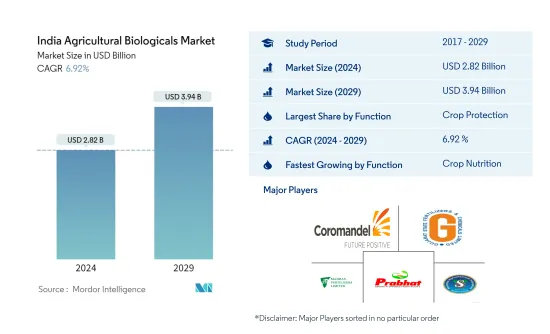Need help finding what you are looking for?
Contact Us
PUBLISHER: Mordor Intelligence | PRODUCT CODE: 1431271

PUBLISHER: Mordor Intelligence | PRODUCT CODE: 1431271
India Agricultural Biologicals - Market Share Analysis, Industry Trends & Statistics, Growth Forecasts (2024 - 2029)
PUBLISHED:
PAGES: 218 Pages
DELIVERY TIME: 2-3 business days
SELECT AN OPTION
The India Agricultural Biologicals Market size is estimated at USD 2.82 billion in 2024, and is expected to reach USD 3.94 billion by 2029, growing at a CAGR of 6.92% during the forecast period (2024-2029).

Key Highlights
- Crop Protection is the Largest Function : India faces high incidence of pests and diseases affecting the crop production, leading to higher demand for crop protection inputs. Biocontrol agents dominate the market.
- Amino Acids is the Fastest-growing Form : The main field crops grown in India are rice, wheat, maize, millet, pulses, and oilseeds which consuming more amino acid-based biostimulants and accounted for 89.5% in 2022.
- Biostimulants is the Fastest-growing Type : Biostimulants as active ingredients are increasingly being used in the Indian biologicals market, the market value of which increased by 15.7% between 2017 and 2022.
- Row Crops is the Largest Crop Type : The dominance of row crops is mainly due to their large organic cultivation areain the country, which accounted for about 59.8% of the total organic crop area in 2022.
India Agricultural Biologicals Market Trends
Crop Protection is the largest Function
- The overuse of chemical fertilizers and pesticides is one of the serious challenges in the country. The continuous use of nitrogen at fixed sites had a negative impact on the health of the soil and crop yield, indicating deficiencies in several macro and micronutrients. Even with recommended doses of NPK and more, deficiency of micro and secondary nutrients has become a yield-limiting factor.
- The adoption of sustainable agricultural practices or organic farming can decrease the effect of chemical fertilizers on the environment. The Indian Council of Agricultural Research (ICAR) recommends integrated nutrient management through conjunctive use of both inorganic and organic sources of plant nutrients to reduce the use of chemical fertilizers, preventing deterioration of soil health and environment and contamination of groundwater.
- These factors and the growing organic agricultural cultivation area are driving the Indian agricultural biologicals market. The crop protection segment is dominating the market. It was valued at about USD 1.84 billion in 2022. The crop nutrition segment was valued at USD 551.3 million in the same year.
- Row crop cultivation is dominant in the country, accounting for about 84.9% of the Indian agricultural biologicals market in 2022. The country is promoting organic farming under the Parampragat Krishi Vikas Yojana (PKVY) and the Mission Organic Value Chain Development for North East Region (MOVCD-NER). The demand for organic products in domestic and international markets is also expected to drive the Indian agricultural biologicals market during the forecast period.
India Agricultural Biologicals Industry Overview
The India Agricultural Biologicals Market is fragmented, with the top five companies occupying 21.57%. The major players in this market are Coromandel International Ltd, Gujarat State Fertilizers & Chemicals Limited, Madras Fertilizers Limited, Prabhat Fertilizer and Chemical Works and Swaroop Agrochemical Industries (sorted alphabetically).
Additional Benefits:
- The market estimate (ME) sheet in Excel format
- 3 months of analyst support
Product Code: 500022
TABLE OF CONTENTS
1 EXECUTIVE SUMMARY & KEY FINDINGS
2 REPORT OFFERS
3 INTRODUCTION
- 3.1 Study Assumptions & Market Definition
- 3.2 Scope of the Study
- 3.3 Research Methodology
4 KEY INDUSTRY TRENDS
- 4.1 Area Under Organic Cultivation
- 4.2 Per Capita Spending On Organic Products
- 4.3 Regulatory Framework
- 4.4 Value Chain & Distribution Channel Analysis
5 MARKET SEGMENTATION
- 5.1 Function
- 5.1.1 Crop Nutrition
- 5.1.1.1 Biofertilizer
- 5.1.1.1.1 Azospirillum
- 5.1.1.1.2 Azotobacter
- 5.1.1.1.3 Mycorrhiza
- 5.1.1.1.4 Phosphate Solubilizing Bacteria
- 5.1.1.1.5 Rhizobium
- 5.1.1.1.6 Other Biofertilizers
- 5.1.1.2 Biostimulants
- 5.1.1.2.1 Amino Acids
- 5.1.1.2.2 Fulvic Acid
- 5.1.1.2.3 Humic Acid
- 5.1.1.2.4 Protein Hydrolysates
- 5.1.1.2.5 Seaweed Extracts
- 5.1.1.2.6 Other Biostimulants
- 5.1.1.3 Organic Fertilizer
- 5.1.1.3.1 Manure
- 5.1.1.3.2 Meal Based Fertilizers
- 5.1.1.3.3 Oilcakes
- 5.1.1.3.4 Other Organic Fertilizers
- 5.1.2 Crop Protection
- 5.1.2.1 Biocontrol Agents
- 5.1.2.1.1 Macrobials
- 5.1.2.1.2 Microbials
- 5.1.2.2 Biopesticides
- 5.1.2.2.1 Biofungicides
- 5.1.2.2.2 Bioherbicides
- 5.1.2.2.3 Bioinsecticides
- 5.1.2.2.4 Other Biopesticides
- 5.1.1 Crop Nutrition
- 5.2 Crop Type
- 5.2.1 Cash Crops
- 5.2.2 Horticultural Crops
- 5.2.3 Row Crops
6 COMPETITIVE LANDSCAPE
- 6.1 Key Strategic Moves
- 6.2 Market Share Analysis
- 6.3 Company Landscape
- 6.4 Company Profiles
- 6.4.1 Coromandel International Ltd
- 6.4.2 Gujarat State Fertilizers & Chemicals Limited
- 6.4.3 Indian Farmers Fertiliser Cooperative Limited
- 6.4.4 Koppert Biological Systems Inc.
- 6.4.5 Madras Fertilizers Limited
- 6.4.6 Prabhat Fertilizer and Chemical Works
- 6.4.7 Rallis India Ltd
- 6.4.8 Samriddhi Crops India Pvt. Ltd
- 6.4.9 Swaroop Agrochemical Industries
- 6.4.10 Valagro
7 KEY STRATEGIC QUESTIONS FOR AGRICULTURAL BIOLOGICALS CEOS
8 APPENDIX
- 8.1 Global Overview
- 8.1.1 Overview
- 8.1.2 Porter's Five Forces Framework
- 8.1.3 Global Value Chain Analysis
- 8.1.4 Market Dynamics (DROs)
- 8.2 Sources & References
- 8.3 List of Tables & Figures
- 8.4 Primary Insights
- 8.5 Data Pack
- 8.6 Glossary of Terms
Have a question?


SELECT AN OPTION
Have a question?


Questions? Please give us a call or visit the contact form.
